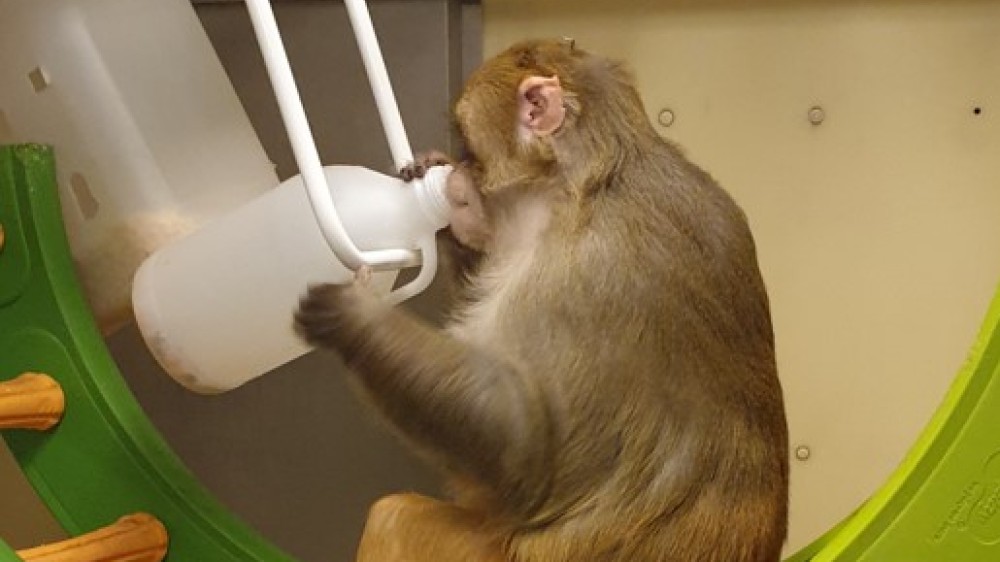Example enrichment study protocols
Options for evaluation
- Choose a statement to help you select the example protocol that is most likely to meet your needs.
- Scroll to the relevant protocol and download the example.
- The example protocols are designed to be adapted by substituting in your own animals and enrichment for evaluation. Read the step by step instructions for guidance on how to take a methodological approach to your evaluation.
- Good planning will help you carry out an successful evaluation and the pages on Planning an enrichment evaluation and How to improve the scientific quality of your study will help you with this.
- You can also use the General advice on adapting the protocols and read examples from the literature that are available online.
- Observe behaviour, focusing on frequency or duration of negative welfare indicators, consider adapting:
- For visible indicators of poor welfare, such as barbering, data can also be recorded during welfare checks.
- Observe behaviour with and without the enrichment and make comparisons between these two.
- Observe behaviour, focusing on positive and negative welfare indicators. Consider adapting:
- Observe behaviour with and without the enrichment and make comparisons between these two.
- Protocol A could be adapted.
- A preference test may be suitable, for which you could adapt Protocol D.
- Preference for edible items within a group can be indicated by how much is eaten or chewed. You can use a scoring system or weigh items before introducing them to the cage and 24 hours later. These observations can be made for the group, so there is no need to singly house individuals.
- A motivation or 'consumer demand' test may be suitable.
- We do not currently have an example protocol but if you would like help planning this more advanced approach to evaluating enrichment contact us at tech3rs@nc3rs.org.uk
Protocol A: Use of an enrichment item (mouse mezzanine with shelter)
Type: Behavioural observation
Preparation: Create ethogram and playroom
Observation: Daily flexibility; approx. 5 – 40 min per day
(Page 5 of main protocol document)
(Page 1 of general ethograms document)
Protocol B: Playrooms for rats
Type: Behavioural observation
Preparation: Create ethogram and playroom
Observation: Daily flexibility; approx. 20 – 45 min per day
(Page 8 of main protocol document)
(Page 4 of general ethograms document)
Protocol C: Video recording zebrafish behaviour
Type: Behavioural observation
Preparation: Create ethogram, set up and test recording equipment
Observation: Daily flexibility; approx. 20 – 45 min per day
(Page 6 of main protocol document)
(Page 6 of general ethograms document)
Protocol D: preference test
Type: Preference test
Preparation: Modify cages
Observation: Daily flexibility; approx. 5 – 10 min
(Page 6 of main protocol document)
Examples of enrichment evaluations available online
|
Reference |
Evaluation type |
Study animals |
Evaluation of |
Statistics |
|---|---|---|---|---|
|
[1] Windsor and Bates (2019) |
Nest scoring Safety observations |
Mice |
Four types of nesting material |
AVOVA |
|
[2] Schroeder et al. (2014) |
Preference test |
Zebrafish |
Different types of structural enrichment (sand, gravel and artificial plants) |
Kruskall-Wallis test; Wilcoxon test |
|
[3] Van Loo et al. (2004) |
Preference test |
Mice |
Nest boxes and nesting material |
Binomial test; t-test |
|
[4] Czezyk et al. (2020) |
Preference test Behavioural observation |
Zebrafish |
Different types of structural enrichment (plastic plant, shelter, plastic lily pad) |
ANOVA |
|
[5] Li et al. (2019) |
Preference test Behavioural observation |
Piglets |
Music |
ANOVA |
|
[6] Tilly et al. (2010) |
Behavioural observation Motivation test |
Mice |
Smaller cage versus larger cage with more structural enrichment |
Generalised linear model |
|
[7] Hanmer et al. (2010) |
Motivation test |
Rats |
Various toys and objects (e.g. polyester and fur covered blocks) |
ANOVA; t-test |
| [8] Kahnau et al. (2022) | Motivation test (automated and home-cage based) | Mice | Liquids (water, bitter, sweet) | Linear mixed-effects model |
References
- Windsor Z and Bate ST (2019). Assessing the safety and suitability of nesting material for singly housed mice with surgically fitted head plates. Heliyon 5(7): e02097. doi:10.1016/j.heliyon.2019.e02097
- Schroeder P et al. (2014). What do zebrafish want? Impact of social grouping, dominance and gender on preference for enrichment. Laboratory Animals 48(4): 328-337. doi:10.1177/0023677214538239
- Van Loo PL et al. (2005). Assessment of the use of two commercially available environmental enrichments by laboratory mice by preference testing. Laboratory Animals 39(1): 58-67. doi:10.1258/0023677052886501
- Czezyk A et al. (2020). Does Providing Hiding Spaces for Zebrafish in Large Groups Reduce Aggressive Behaviour? Journal of Young Investigators 38(5). doi:10.22186/jyi.38.5.43-56
- Li X et al. (2019) Behavioural responses of piglets to different types of music. Animal 13(10): 2319-2326. doi:10.1017/S1751731119000260
- Tilly SLC et al.(2010). Middle-aged mice with enrichment-resistant stereotypic behaviour show reduced motivation for enrichment. Animal Behaviour 80(3): 363-373. doi:10.1016/j.anbehav.2010.06.008
- Hanmer LA et al. (2010). Using a runway paradigm to assess the relative strength of rats’ motivations for enrichment objects. Behavior research methods 42(2): 517-524. doi:10.3758/BRM.42.2.517
- Kahnau P et al. (2022). Determining the value of preferred goods based on consumer demand in a home-cage based test for mice. Behavior Research Methods 1-16. doi: 10.3758/s13428-022-01813-8
Guidance on modifying our example protocols to design your own studies. (Image credit: University of Cambridge.)

